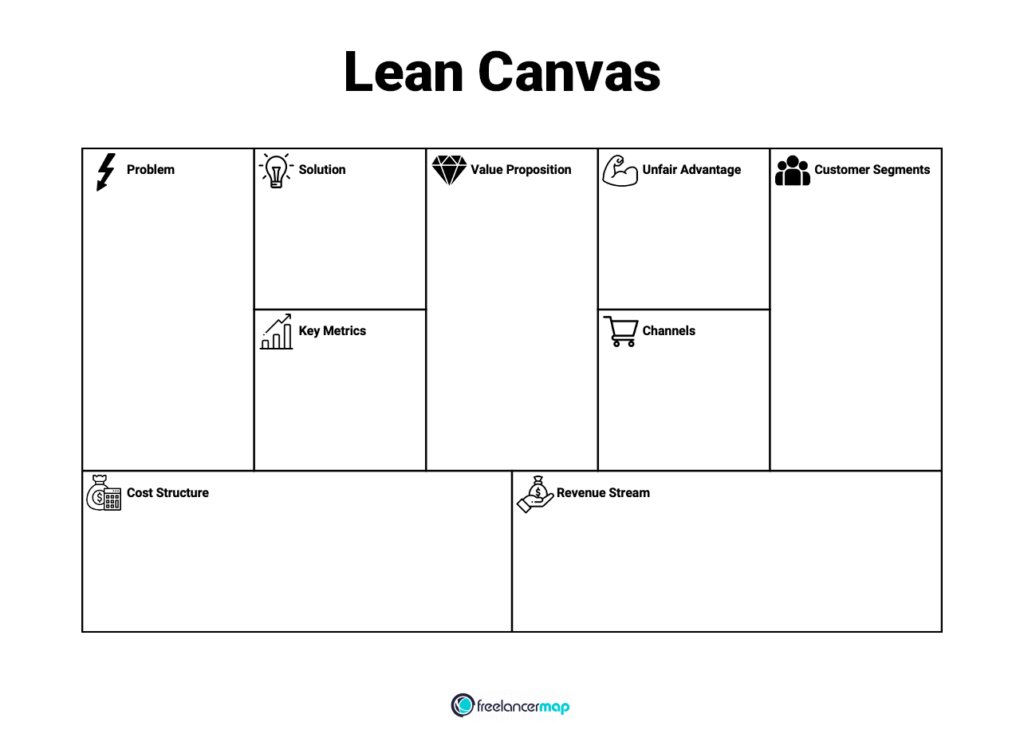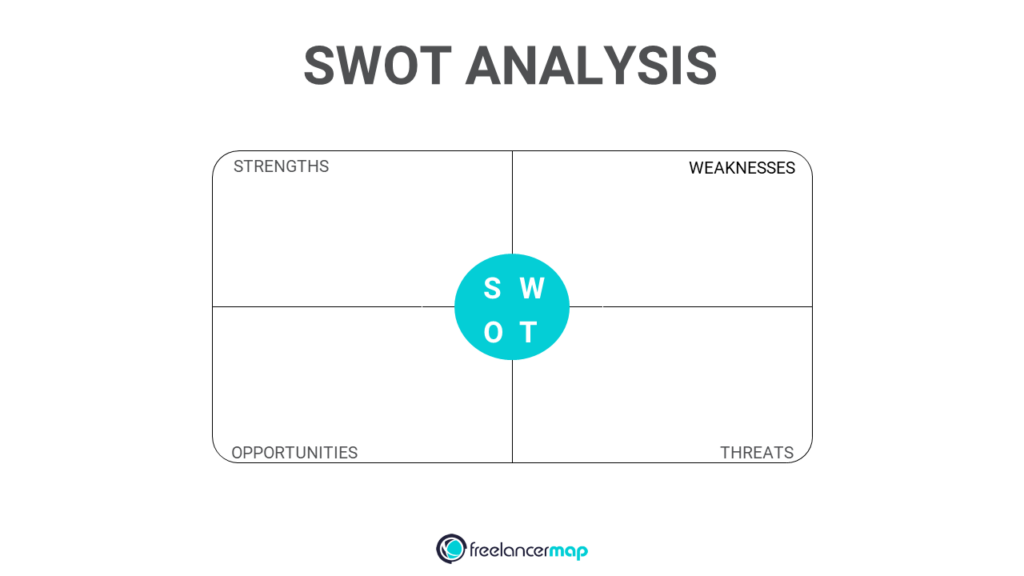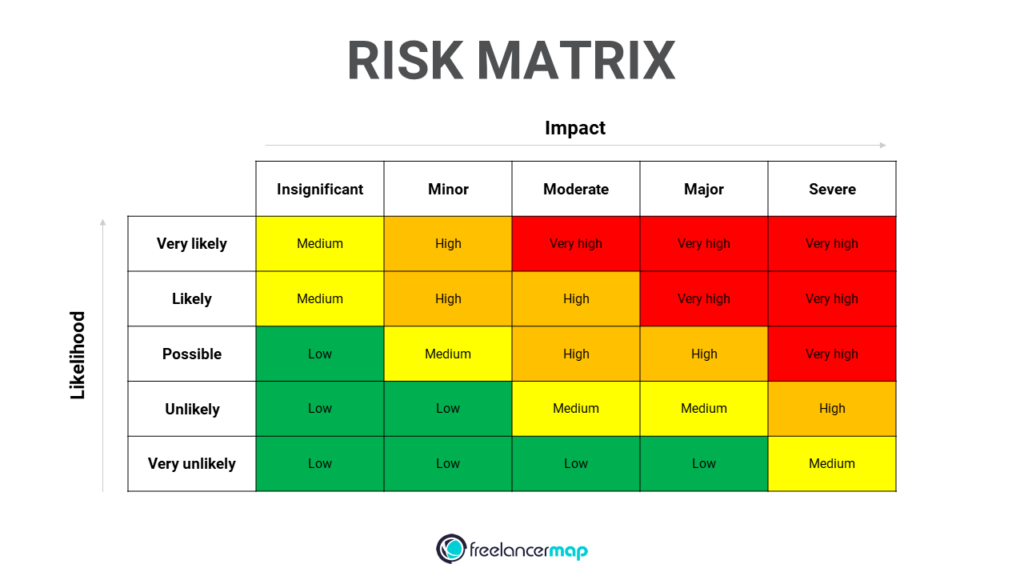Having a solid freelance business plan is crucial for achieving long-term success. While you may not have the same traditional structure as a brick-and-mortar business, it’s essential to have a roadmap that outlines your goals, target audience, and financial projections. In this article, we’ll discuss the key components of a business plan for freelancers and offer tips on how to create a plan that sets you up for success.
- Purpose of a business plan
- Benefits and advantages
- The Business Model Canvas
- Value Proposition
- Customer Segments
- Channels
- Customer Relations
- Key Partners
- Key Resources
- Key Activities
- Revenue Stream
- Cost Structure
- The Lean Canvas
- Freelance business plan template + checklist
- Executive Summary
- Company and Strategy
- Products and Services
- Market Analysis
- Competitors
- Marketing and Sales
- Organization and Resources
- Risk Analysis
- Financing
- Action Plan
- Appendix
- Common mistakes when creating a business plan
Purpose of a freelance business plan
A business plan forms the foundation of your company. It records the business idea and all the important components that contribute to its success or failure. Therefore, a business plan not only helps to get an idea of what the chances of success are for a plan, but also serves to keep an eye on the development of the company after the start-up, and to make target-actual comparisons and counteract negative changes in a timely manner.
In addition to its internal purpose, a business plan also fulfils external tasks. When starting a business, it especially serves as a basis for evaluation by external capital providers.
A good business plan can already be helpful in the start-up phase to convince potential investors, banks, authorities, as well as potential sales partners, customers or suppliers of the business idea.
However, before diving straight into the creation of a business plan, one should first engage with their business idea in order to illuminate it from all sides. This not only helps to avoid early failure, but also makes the creation of a freelance business plan much easier.
Why use a business plan? Benefits and advantages
Before you start creating the perfect freelance business plan, let’s take a look at the benefits and advantages that it can offer:
- Increased clarity: A business plan can help you get clarity to your decision-making process and helps you put your end goal at the core and work towards it.
- Provides clear structure: A business plan provides structure and allows you to define business objectives. When consulted regularly, it can help measure and manage your areas of focus that are of the utmost priority.
- Creates a marketing roadmap: A business plan allows you to create an effective marketing roadmap, which in turn can help you define things like target market(s), target customers, schedules, timeframes, etc.
- Improved financial decisions: Planning for expenses effectively is crucial when it comes to freelancing. A business plan gives you the information needed to make better decisions financially.
The Business Model Canvas
To analyse the potential of a business idea, one can use a variety of methods. One of the most comprehensive tools for this is the Business Model Canvas by Alexander Osterwalder. In this method, a business idea is placed at the centre and related to 9 dimensions – the so-called building blocks:
- Value Proposition
- Customer Segments
- Channels
- Customer Relations
- Revenue Streams
- Key Partners
- Key Resources
- Key Activities
- Cost Structure


During the development and analysis of the business idea, all fields are filled with the corresponding contents. Plan to spend two to three hours working on these fields. It is important to take enough time to consider the thoughts for each building block, but not to plan every field in detail. Remember, the completion of the Business Model Canvas should only show whether the business idea is feasible and serves as a guide for what needs to be considered.
Value Proposition
The Value Proposition defines the extent to which the business model brings benefits to the customer. The following questions help to define the promise of performance:
- What problem am I solving?
- What exactly am I offering?
- Why are customers looking for my service specifically?
- What makes my offer better than the competition?
Customer Segments
Next is the definition of the target audience or customers. It is important to define customer segments that will buy your services or products. Potential customers are grouped together based on their characteristics. The group characteristics can be traditional demographic factors (age, gender, location, etc.) or can focus on purchasing behaviour or reasons for buying.
Channels
Next, the channels through which you want to inform your customers about the product or service are defined. It is important to find out where and how potential customers shop. Here are some questions to answer:
- How and where do customers find out about the offering?
- How do customers become aware of my product or service?
- How can customers buy my products and services?
- How do I provide the service or how does the service reach my customers?
To capture all relevant touchpoints between customers and your business, it is recommended to record the so-called customer journey. Here, you put yourself in your customer’s shoes and document every step he or she takes from gathering information to making a purchase (and possibly beyond). This will help you identify the channels that you need to establish and manage for your business.
Customer Relations
If you have already thought about the customer journey, you’re halfway to defining customer care. It is not only important to consider how to attract and win customers, but also how to keep the ones you already have. Consider the following questions:
- What options do you have to communicate with your customers?
- Is there a customer service hotline, a contact form, an email address?
- How do customers learn about your new offerings?
Key Partners
In the next step, you will think about possible partnerships and how you and your business depend on them. This includes suppliers and vendors, as well as technology partners or regulatory bodies that you need to work with. Focus on the really relevant partners without whom you couldn’t do your job.
Key Resources
The same applies to Key Resources. Here, the resources needed for your work are listed, including:
- Employees or roles that need to be filled
- Financial resources and capital
- Intangible resources such as licences, brands, patents, etc.
- Material resources such as laptops, office equipment, company cars, etc.
Of course, not every pencil you need to buy for your business needs to be listed here. The focus should be on the critical resources for success.
Key Activities
The definition of Key Activities is one of the simpler tasks in the Business Model Canvas. Here, all activities that contribute to the success of the business model are listed. The other components of the business idea also contribute to this, which is why it is worth deriving the Activities from them.
In general, you need to ask yourself what activities need to be performed to fulfil the value proposition, win customers, and maintain day-to-day operations.
Revenue Streams
Next, it is important to define how you make money with your business. For freelancers, this means defining their hourly rate or considering other revenue models to generate income. Are there perhaps special contracts that bring recurring revenue or are only the hours billed each time? Define all essential sources of revenue and how they work.
Cost Structure
Lastly, the cost structure is defined. The most important variable and fixed costs and their causes must be identified. These may include:
- Production costs
- Marketing costs
- Rent
- Licence costs
- Personnel costs
The Lean Canvas
As a further development of the Business Model Canvas, the Lean Canvas became known in 2010. It is specifically adapted to the fast-paced and limited resources of a startup and focuses on the problem to be solved and the solution to be provided, as well as the so-called unfair advantage and the core metric. In the Lean Canvas, these elements replace the Key Activities, Partners, Resources, and Customer Relations.


Often business ideas fail because they don’t solve a relevant problem. Therefore, this component was added to the Lean Canvas.
Once the problem to be solved has been identified, the focus shifts to providing a corresponding solution quickly and easily. The Lean Canvas approach involves using an MVP (minimum viable product). The MVP represents the minimum version of the solution – the raw version. This is launched on the market as soon as possible and then further developed in collaboration with customers.
The unfair advantage essentially describes the competitive advantage. For startups, it is important to know this very well or, if it does not exist from the beginning, to define it.
Young companies often lose themselves in the masses of numbers and metrics that define the success of a business. To prevent this, entrepreneurs who choose the Lean Canvas approach should first define only one metric from which they can measure success and failure. At the beginning, when the survival of the company is paramount, this could be profit. Later, when it comes to growth, other metrics come into play.
How to create a freelance business plan – Template + checklist
For those who have thoroughly considered their business idea beforehand, writing a freelance business plan will be easy. The elements of the Business Model Canvas or the Lean Canvas often overlap with the elements of the business plan and only need to be worked out in more detail. The planned size and complexity of the business idea also determine the content and scope of the plan.
The following elements provide a guide for creating your freelance business plan:
1. Executive Summary
The Executive Summary is a brief overview of the business plan. The business idea is explained briefly and concisely, usually along with the purpose, objectives, and goals of the business. The industry and growth potential of the market are described, and finally, the key investment and financial data are presented.
Write the Executive Summary at the end of the business plan. It serves as a compact overview of the business idea and as the first evaluation criterion for the potential success of the business model and its financing for potential investors.
The chapter, which should be no more than one and a half pages long, includes:
- Business idea
- Offer – products & services
- Industry / Market
- Growth potential of the market
- Financial requirements
2. Company & Strategy
In this section, the foundation for the company’s concept is laid out. The approaches for a successful implementation are presented in detail. It is also important to highlight the arguments and strengths of the idea and the planned company. These can be supported, for example, by a SWOT analysis.
The following sub-chapters are included:
- Company:
- Founding history
- Founders
- Legal form
- Milestones, capital, and shareholder structure
- Business idea
- Business goal
- Business purpose
- Vision and strategy


3. Products & Services
This section of a freelance business plan contains all information about your products and services. Define them precisely, describe their unique selling points, and think about pricing segments.
The subchapters include:
- Products or services
- Product or service advantages
- Pricing segments
4. Market Analysis
For a successful business, the appropriate market potential must be present. Therefore, the selected market must be analysed in detail. Identify customer groups and define strategic business areas. The topics to be addressed include:
- The market
- Market volume
- Market position and market shares
- Growth potential
- Framework conditions (economic and legal factors)
- Entry barriers
- Competitive analysis
- Customer analysis
- Customer groups (segmentation)
- Strategic business areas (product per segment)
- Market objectives
- Outlook on potentials and future.
5. Competition
Here you take a look beyond your own company and get an idea of who your direct competitors are, who your market companions are, and how the situation can develop in the future. The following points belong in the competition analysis:
- Direct competitors
- Their products and services
- Their strengths and weaknesses
6. Marketing & Sales
For a business idea to succeed, the right marketing and promotion of the product or service is crucial. Here, you describe the marketing concept and your marketing mix, where you define what you market where, how, and at what cost. Common models for processing are, for example, the 4 or 7 P’s. In addition, the marketing concept should include all important key points for the timeframe of market entry. The sub-chapters for this chapter include:
- Product
- Sales and distribution strategy, distribution channels
- Pricing, price policy
- Communication strategy, channels, advertising, PR
7. Organisation & Resources
For the successful development of a company, resources, management, and employees play an important role. Therefore, this part Organization and Resources describes everything that is important for the organisation of the company, production, or service provision. This includes points such as:
- Production process (location, technology, capacities, etc.)
- Suppliers
- Inventory management
- Research & Development
- Legal situation
- Patents/licences
- Responsibilities
- Management
- Personnel
- Development/expansion potential
8. Risk Analysis
In this section, possible opportunities and risks are described, as well as measures to counteract the risks. In classic risk analysis, risks and their consequences are listed and classified according to the likelihood of occurrence.


The risk matrix provides information about which risks are critical. For risks in the high and extreme categories, measures to limit or remedy them must be defined. Potential risks can be found, for example, in:
- Management / personnel
- Production
- Finance
- Technology
- Processes
- Insurances
- Politics
9. Financing
A business plan for a planned self-employment cannot be created without detailed financial planning. Create the financial plan in the business plan for a period of 3-5 years to increase planning security. The following topics belong in the financial plan:
- Cost structure
- Revenue cycle
- Cash flow plan – comparison of expenses and revenues
- Profit planning – profit and loss statement
- (Planned) balance sheet – overview of asset ratios
- Required capital / investments
10. Action Plan
No matter how detailed your business plan is, it won’t help if it doesn’t lead to a structured and realistic action plan. Define all the steps that need to be taken until your product or service is on the market. You can use the chapters of the business plan as a guide. The next steps need to be defined, for example, for:
- Product/Service
- Business start-up/Company
- Personnel
- Resources/Partners
- Marketing/Market entry
- Location/Business premises
- etc.
11. Appendix
In the appendix, documents can be included that would exceed the scope of the respective chapter. For example, the following can be included:
- Resumes / Founders’ Profiles
- Financial planning (Balance Sheet, Income Statement, Cash Flow)
- Operating permits / Patents
- Organisational charts
📌 Business Model checklist ➯ DOWNLOAD
Common mistakes when creating a business plan (and how to avoid them)
When it comes to such a labour-intensive process as creating a business plan, it can be frustrating when errors creep in. To help you with this, we’ve identified the most common sources of errors below and provide tips on how to avoid them:
Lack of knowledge (e.g. in the area of finance)
- Scrutinise the areas where you are unsure, especially critically.
- Acquire any missing knowledge if necessary.
- Seek out partners and advisors who have the expertise you lack.
Missing structure in the business plan
- Pay attention to the logical structure of the business plan. The chapters and subchapters can follow a different order in your plan if it makes more sense for your business idea.
- Focus on the important components of your business plan, which may vary depending on the purpose of the plan (investor pitch, business planning, etc.)
- Various organisations offer consulting services to entrepreneurs, some of which are even subsidised by the states.
Insufficient differentiation
- Even if your idea seems incredibly unique to you, a comprehensive competitor analysis is necessary.
- This is the only way to define a convincing unique selling proposition (USP) – which is also essential for the success of your business idea.
- Not only does the business idea need unique selling propositions, but each product and service also needs to stand out in the market. Therefore, define a unique value proposition (UVP) for your products and services as well.
Underestimating risks
- Nobody becomes self-employed overnight without careful consideration. Therefore, inform yourself carefully about the risks of self-employment and choose your approach consciously.
- Use various analysis tools to minimise risks.
Poor planning
- It’s easier to take the next steps if they are specifically planned and written down. A dedicated action plan of the individual steps is therefore essential to make the business plan a reality.
- To avoid suddenly facing insurmountable obstacles, a secure risk planning is needed. Make sure to think this through thoroughly before embarking on the adventure!
—
These articles might be interesting too:
